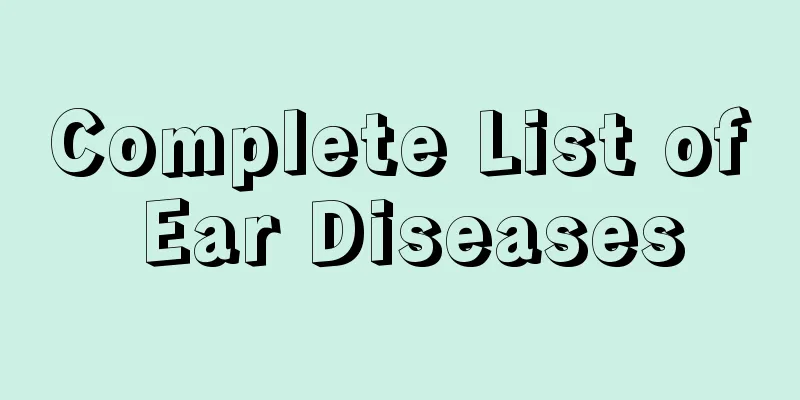Complete List of Ear Diseases

|
Everyone should pay attention to the health of their ears in life, because only healthy ears can maintain normal hearing. Therefore, ear health should be an important issue that everyone pays attention to. The ear is a part that people do not pay much attention to in daily life, so people do not know much about ear diseases. In summary, there are mainly the following types of ear diseases. Ear diseases include ear inflammation, deafness, tumors, etc. The pathogenesis is wide-ranging, and severe deafness can leave a person semi-disabled. There are the following: Earache Earache is mainly caused by acute inflammation, such as acute suppurative perichondritis, external otitis and furunculosis, acute myringitis and acute suppurative otitis media. In the late stage of middle ear cancer, there may be severe pain. Otogenic intracranial complications may present with deep ear pain. Ear discharge Ear discharge is the discharge of secretions from the external auditory canal and is one of the common symptoms of ear diseases. The discharge from otitis externa is often exudative, while the discharge from otitis media is often mucopurulent. A larger amount means that the mastoid is also affected. When the discharge from chronic otitis media is foul-smelling, cholesteatoma otitis media should be suspected. deaf Deafness Deafness can occur when there is a lesion in any part of the auditory system. However, if different parts of the body are affected, different types of deafness will occur. Lesions in the external ear and middle ear will cause conductive hearing loss. Cochlear lesions and acoustic neuromas can cause sensorineural hearing loss. When there is a lesion above the cochlear nucleus, it is central deafness. In addition, there is functional deafness and pseudo-deafness. Modern audiometry technology can provide qualitative and localized diagnosis for various types of deafness. Mixed deafness refers to deafness that has both conductive deafness and sensorineural deafness (see deafness). tinnitus Tinnitus can be caused by various ear diseases such as acoustic trauma and drug-induced deafness. In addition, high blood pressure, kidney disease, and senile deafness can also cause it. The cause can be found based on medical history and physical examination (see tinnitus). dizziness Vertigo is the illusion that one or the surrounding environment is rotating. It can be divided into two types: otopathic (peripheral vestibular disease) and central. Otogenic vertigo (such as Meniere's disease) is characterized by sudden onset, accompanied by nausea, vomiting, nystagmus, tinnitus, and hearing loss. Symptoms do not last long. Central vertigo is generally accompanied by sensorineural hearing loss or no hearing loss, the nystagmus is not obvious, the vertigo is mild or just a feeling of instability. Such as acoustic neuroma (see vertigo). Local swelling Local swelling, such as swelling caused by auricular perichondritis, local redness and swelling caused by acute mastoiditis, subperiosteal abscess of the mastoid, furuncle of the external auditory canal, etc. Otogenic facial nerve palsy Otogenic facial nerve paralysis Facial nerve paralysis in acute otitis media is mostly caused by facial nerve edema, ischemia, and hypoxia. Chronic suppurative otitis media and mastoiditis are mostly caused by the destruction of the facial nerve bone canal due to the concomitant cholesteatoma, resulting in facial nerve paralysis. Facial nerve palsy can also be caused by middle ear surgery trauma or viral infection. The basic clinical symptoms are disappearance of forehead wrinkles on the injured side, inability to close the eyes, relaxation of facial muscles, and deviation of the mouth corners toward the healthy side, resulting in facial asymmetry. Inspection method Relationship between the inspection method and other ENT diseases and systemic diseases Diseases of the nose and nasopharynx, such as nasal inflammatory diseases, sinusitis, nasal tumors, and nasopharyngeal tumors, are all prone to cause middle ear diseases. Because the Eustachian tube opens on the side wall of the nasopharynx, near the posterior nasal opening, infections can easily enter the middle ear through the Eustachian tube. Children, in particular, have short and straight Eustachian tubes, which are more susceptible to infection. Milk during breastfeeding can also enter the middle ear through the Eustachian tube. In addition, adenoids and tonsils that proliferate and hypertrophy in childhood are also prone to cause otitis media. Systemic diseases such as upper respiratory tract infections often induce otitis media. Chronic diseases such as hypertension, kidney disease, diabetes, and metabolic diseases can all cause ear dysfunction, manifested as deafness, tinnitus, or dizziness. Diagnosis and differential diagnosis First, make a preliminary diagnosis based on the time of onset, possible causes and physical examination results. For difficult cases, special examinations can be performed based on clinical characteristics. For example, for deaf patients, various audiometric methods can be used. The results can often reflect the nature of the disease and the location of the lesion. For young children and uncooperative cases, objective audiometry can be used. Electronystagmography can provide clues to the nature of vertigo and the location of the lesion. In addition, some cases require X-rays, biopsies and other examination items to assist in diagnosis. The differential diagnosis should be noted in the following situations: 1. Conductive hearing loss. Ossicular chain interruption and otosclerosis are easily confused. Medical history and acoustic impedance audiometry are helpful for differential diagnosis. Surgical exploration can be performed if necessary. Second, sensorineural hearing loss. We can start from the etiology and clinical characteristics. For example, the onset of various diseases is not exactly the same. Infection, vascular disease, and blast hearing loss often occur suddenly. However, hearing loss caused by systemic diseases such as acoustic neuroma, diabetes, and cirrhosis progresses slowly. The causes of hearing loss in one ear or both ears may be different. For example, occupational hearing loss and drug-induced hearing loss often damage both ears at the same time. Meniere's disease and middle ear disease are mostly unilateral, and the vestibular function is different. The vestibule is often damaged by inner ear lesions, which manifests as low function. The vestibular function of congenital and occupational hearing loss is usually normal. Special audiometry can distinguish cochlear, neural, and central hearing loss. 3. Vertigo. Medical history plays an important role in the diagnosis of vertigo. In addition, the nature and degree of vertigo caused by various diseases are also different. |
<<: Both ears are buzzing_feeling ears are buzzing
>>: One side of the ear is blocked
Recommend
What is renal cancer invasion
Kidney cancer is a very common malignant tumor in...
How to whiten teeth with baking soda
Have you ever heard of baking soda for whitening ...
What are the symptoms of severe aortic valve stenosis?
Aortic stenosis refers to a condition in which th...
What are the symptoms of brain tumors? Be careful if you have these 10 symptoms
Brain tumors can affect the functions of various ...
How long to roast hazelnuts in microwave
In life, many people like to eat hazelnuts. Hazel...
Treatment methods for cervical precancerous lesions What are the symptoms of cervical precancerous lesions
Cervical cancer is not cancer at the beginning. I...
What to do if black marks are left after mole removal
Moles are a physical form found on many people. T...
Symptoms of advanced thyroid cancer
Advanced thyroid cancer symptoms often cause conc...
Reasons for rapid heartbeat after meals, many dietary precautions
Many times we will find that our heart rate will ...
I don't know why I'm hungry
Hunger and fullness are normal physiological reac...
What should I do if my tonsils and adenoids are enlarged?
When a patient has enlarged tonsils, he or she mu...
What disease does a mixed taste in the mouth indicate?
Many times we have a bitter taste in our mouth, a...
What are the treatments for primary retroperitoneal tumors
Because primary retroperitoneal tumors can pose a...
Why can't I sit because of back pain
When you often experience lower back pain, you mu...
How to treat prostate enlargement effectively?
Prostate hypertrophy troubles many men, but in da...









